When it comes to stealing data and extorting money from Internet users, scammers can be quite resourceful. They come up with all sorts of things: masquerading as government agencies, posing as bank employees, and doing improper machinations with merchants.
As the number of Internet shoppers grows, more and more people pay for goods and services online, more varieties of scams are appearing on the web. We will tell you what to be wary of and how to protect your business and clients from merchant fraud.

The most popular Merchant Fraud types
We want to warn you right away that there are many kinds of scams, but we chose the most dangerous and widespread ones. As a rule, it is these types of merchant fraud that have the largest number of victims.
Identity theft
Identity theft will still be a major risk. Card protection from fraudsters is still relevant. Fraudsters hack into accounts and use the “stolen” identity to make purchases, paying with someone else’s money. When buying goods over the Internet, the cardholder gives the merchant information about the number and access code of his card. It is this data that becomes the target.
Services for shopping online
Another known method of merchant fraud is Internet sales scams. In times of pandemic, when the bulk of people shops online, the number of such cases has increased. To lure customers, scammers create fake sites for popular (often luxury) brands, offering to buy goods at very low prices. Except that the goods are never delivered to the buyer. Such cases are extremely common in the USA and Europe.
Friendly fraud
It is when the client uses your service or buys goods, but after starts to demand his money back. He claims that his data was stolen, and he never did any transactions. The clients apply to the bank to chargeback their money.
Pure or simple fraud
This type of fraud also involves using stolen cards and identities to place an order.
Money laundering
Money laundering is making the proceeds of criminal activity appear legitimate. In trade-based money laundering, goods are not actually purchased but simply made to look like the purchase itself. Expensive goods and services are used to launder large sums.
Cover anti-fraud system – your tool against any type of fraud
Because of more fraud appearing on the Internet, you should think about protecting your business and customers from it. We recommend you to ask for help from Covery.ai, as their range of services will prevent scammer’s attacks.




